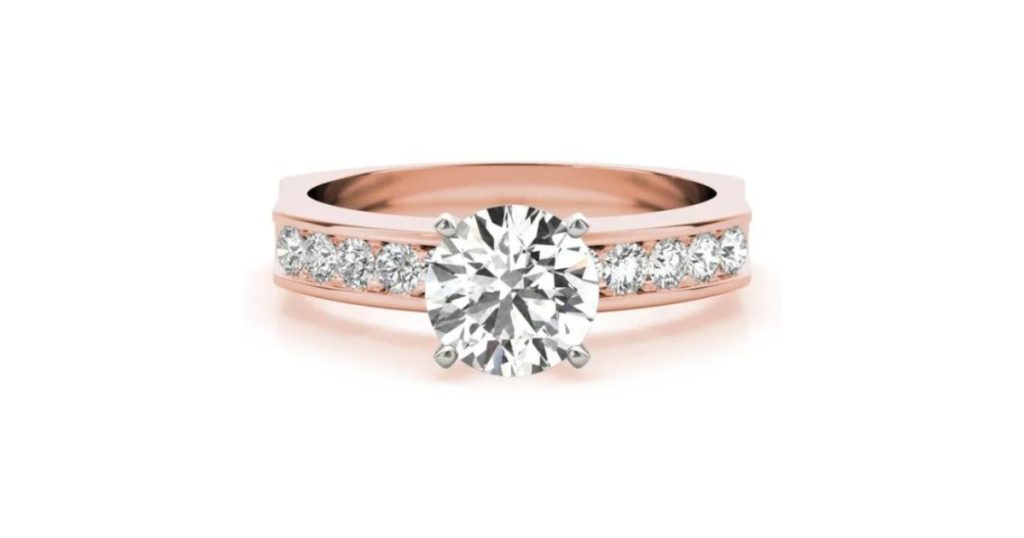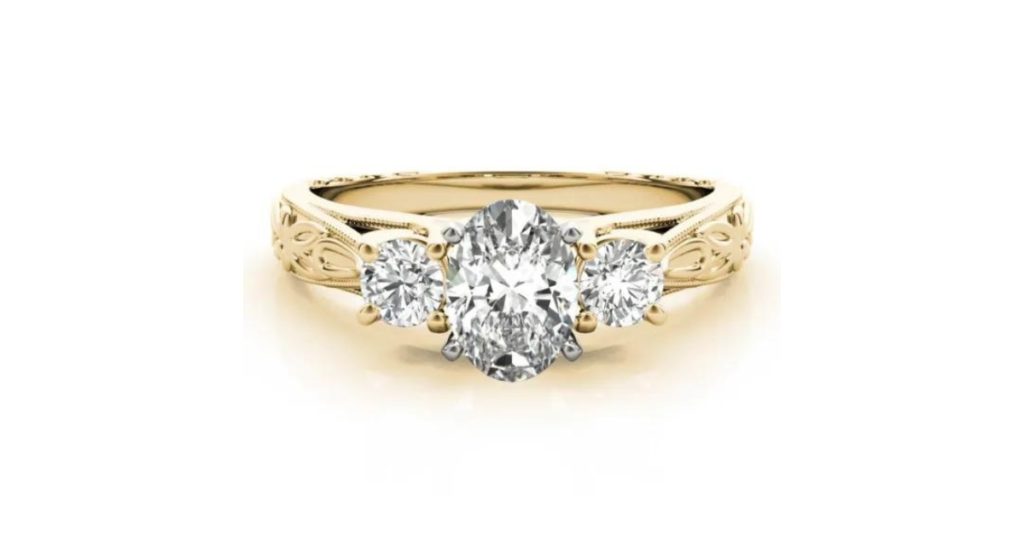If you’re on the search for a beautiful new diamond engagement ring (or any other diamond jewelry), you’ve likely come across the topic of diamond certification. It’s an added cost, but is it really worth it? And what exactly is a certified diamond, anyway?
Let’s go over what a certified diamond is, why certification is important, and how certified diamonds differ from non-certified diamonds.
Certified Diamonds
A certified diamond is a diamond that has been thoroughly evaluated by an independent, unbiased gemological laboratory. Once graded, the diamond receives a document called a diamond grading report.
A diamond grading report verifies the diamond’s authenticity. It also verifies the quality of the diamond and describes its attributes. And within that diamond report are grades based on the 4Cs: cut, color, carat weight, and clarity grade.
Non-Certified Diamonds
A non-certified diamond is not always a “bad” diamond. However, you can never truly know a diamond’s quality or actual value without a diamond certificate from a reputable lab.
If you choose to buy non-certified diamonds, you run the risk of buying diamonds that are not up to par. Essentially, the seller you purchase from can say tell you the diamond quality is excellent (even if it’s not) and charge you a premium.
If you’re in doubt about the quality of a non-certified diamond, it’s best to only consider diamonds that come with diamond certificates from reputable labs.
What Is a GIA Certified Diamond?

There are many independent diamond grading labs, but one of the most widely used and known is the Gemological Institute of America (GIA). When you purchase GIA certified diamonds, you can be sure you’re getting just what you pay for.
The GIA is one of the most reliable sources for diamond grading; it’s also one of the most preferred. This is due to the fact that they have strict grading standards that are both consistent and accurate. In fact, not only is the GIA consistent and accurate when it grades diamonds, but it also set the standard for diamond grading.
The GIA and the 4Cs of Diamond Grading
In the 1940s, GIA founder Robert M. Shipley created the 4Cs. Before this, there were no set standards for grading diamonds.
People in the jewelry industry would often use random terms to describe diamonds. According to the GIA, some of these terms included “Cape” (from the Cape of Good Hope area in South Africa) to describe a diamond with a yellow tint, and “water” or “river” to describe colorless diamonds.
Shipley’s 4Cs were later expanded on by Richard T. Litticoat (also of the GIA). Litticoat’s contributions included the D-Z color scale and clarity scale.
The 4Cs, though a simple concept, are the universal standard for grading diamonds around the globe. In short, a diamond with a GIA diamond grading report holds a lot of weight in the world of diamonds.
With all of this info in mind, we should note that although many labs have adopted the GIA’s system to grade diamonds, it’s not the only system labs use.
The GIA 4Cs Grading Scale in Detail

In order to help you understand the 4Cs, we’ll go over the basics here:
Color Grade
A diamond’s color grade measures its degree of color–basically, the presence or absence of color. According to the color scale of the Gemological Institute of America, grades range from D (colorless and the most expensive) to Z (light yellow or brown, the least expensive).
Carat Weight
The carat weight of a diamond refers to the stone’s weight–it has nothing to do with its physical size. One carat equals 200 milligrams or 0.2 grams. And generally, the higher the carat weight, the more expensive the diamond will be.
Clarity Grade
Arguably one of the most important qualities of a diamond, the clarity grade refers to the presence of or lack of inclusions and blemishes in a stone.
Depending on the types of inclusions or blemishes present in a diamond, its price and quality can fluctuate quite a bit. While not all inclusions and blemishes have a negative effect on a diamond’s quality, some can impede the way light travels through the gemstone. The result is an undesirable effect on its sparkle and shine.
Cut Grade
If clarity grade is one of the most important qualities of a diamond, then cut is the most important–but this depends on your stone’s shape. Often confused with shape, a diamond’s cut grade refers to well-cut facets and proportions.
A diamond’s cut grade can make or break even the most beautiful diamond. If the stone isn’t cut properly, it could appear dull, lifeless, and sans sparkle. This is the exact opposite of what a diamond should be.
In general, cut grade (when evaluated using the GIA grading process) only applies to round diamonds.
Other Reputable Diamond Grading Laboratories

In addition to the GIA, there are plenty of labs worldwide that grade diamonds. The following are just a few examples:
Antwerp World Diamond Center (AWDC)
According to their website: “AWDC takes great pride in representing the world’s leading diamond trade center, where transparency, integrity and quality are part of our heritage, where craftsmanship is a passion and where tradition does not stand in the way of innovation. We are committed to facilitating a favorable business environment while ensuring strict implementation of best practices…”
American Gem Society (AGS)
The American Gem Society (AGS) was founded in 1934. It is an association comprised of jewelry professionals who dedicate themselves to ethical and professional business practices in the jewelry industry.
As stated on their website: “Since 1934, we’ve been making it easier and safer to buy jewelry of any kind. Even if you don’t know the first thing about cut and clarity, we can help you, educate you, and point you in the direction of jewelers that are dedicated to protecting you.”
International Gemological Institute (IGI)
The goals of the International Gemological Institute are extensive. These goals include: ensuring consumer confidence, providing accreditation that meets the highest standards for both lab and natural diamonds, a commitment to sustainability, and a commitment to education.
Do Lab Grown Diamonds Receive a Diamond Certification?

Yes, lab grown diamonds can be (and are) certified. The only difference between lab grown diamonds and natural diamonds is their origin. Aside from this, they are chemically, physically, and optically the same.
And since lab created diamonds are indeed real diamonds, they can be certified and come with a diamond certificate when they are. There is just one distinction between the certificate of a lab grown diamond and a natural diamond; the lab diamond certificate indicates it is lab grown. Other than that detail, they’re the same certificate.
The Benefits of Buying Certified Diamonds

There are several benefits to buying certified diamonds. Whether you choose a GIA graded diamond or go with another trusted lab, two of the best benefits are a quality guarantee and value determination.
Quality Guarantee
When you buy a certified diamond, you can be certain you are getting an authentic diamond. This is because certification provides you with a trustworthy assessment of the diamond’s characteristics.
Value Determination
When you have a certified diamond, you get a good idea of how much it should cost. And if you decide to sell your diamond one day, the certificate will help determine its quality for resale.
Does Clean Origin Sell Certified Diamonds?
Yes, we sell lab created certified diamonds. In fact, we use several independent laboratories to certify our diamonds. But the two most prominent are the International Gemological Institute and Gem Certification and Assurance Lab (GCAL).
Purchase a Certified Lab Diamond With Clean Origin

If you’re ready to buy a certified lab grown diamond, we are here to help. Whether you’re looking for the perfect diamond engagement ring, pendant, or a set of gorgeous diamond studs, we have you covered.
We invite you to visit one of our showrooms to view your jewelry options in person. You can also shop online from the comfort of your home if it’s more convenient.
If you prefer to shop online, we encourage you to make a virtual appointment with one of our friendly diamond experts. They can work with a wide range of budges and are guaranteed to help you find exactly what you want.
Find a showroom near you or contact us today to schedule a virtual appointment.



